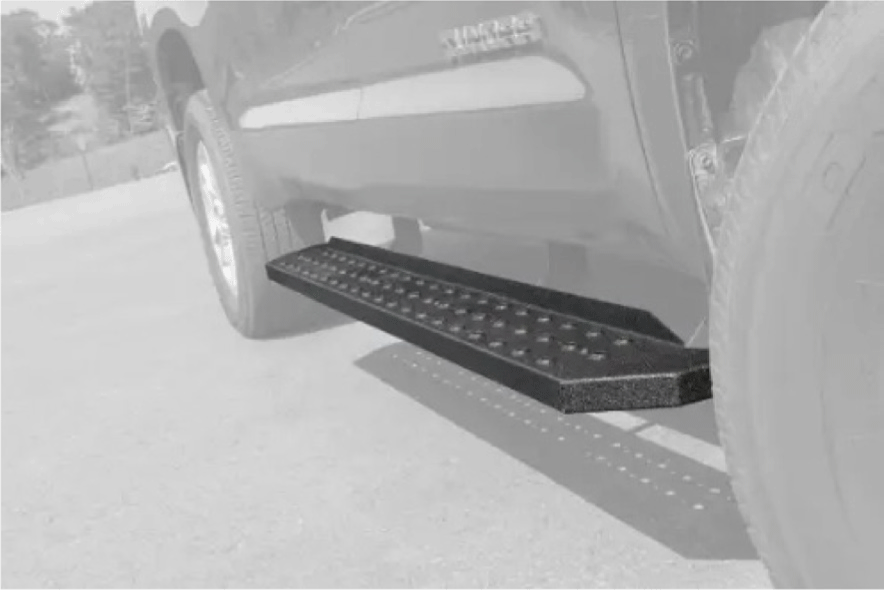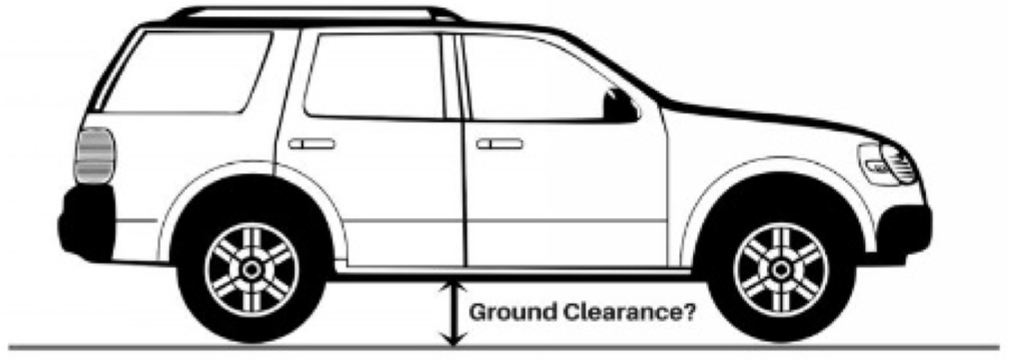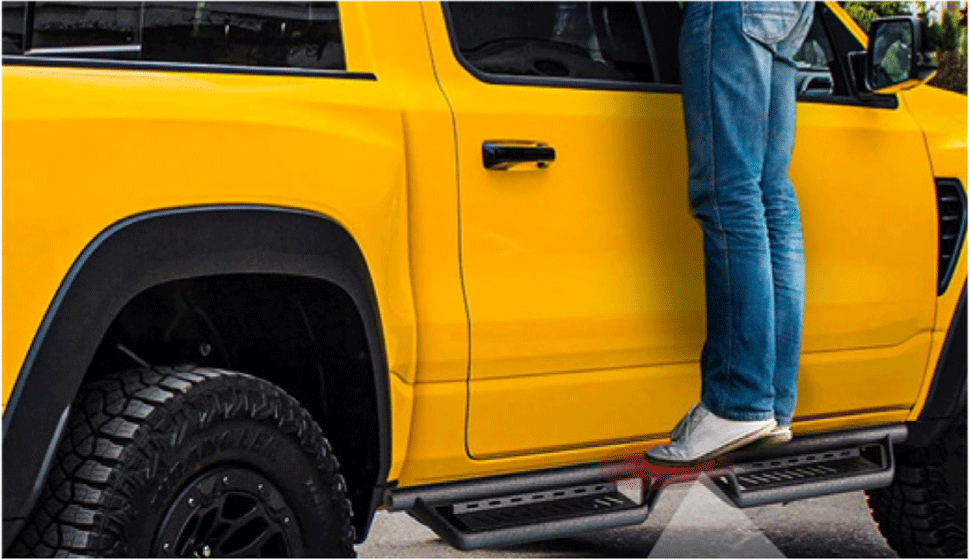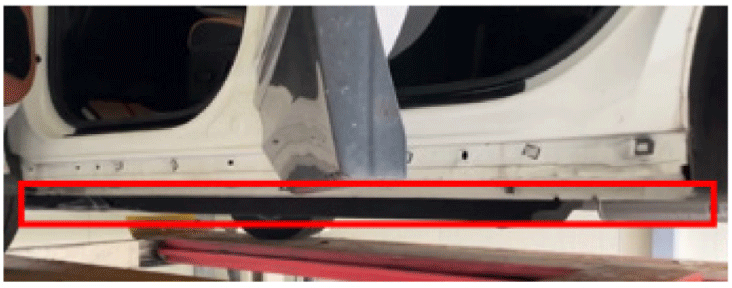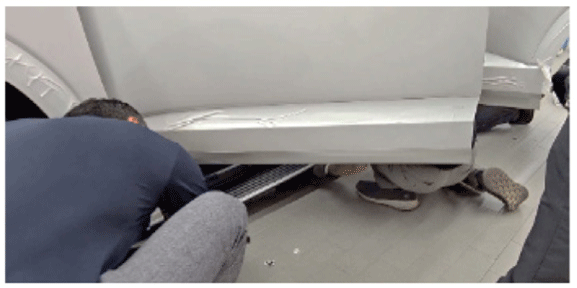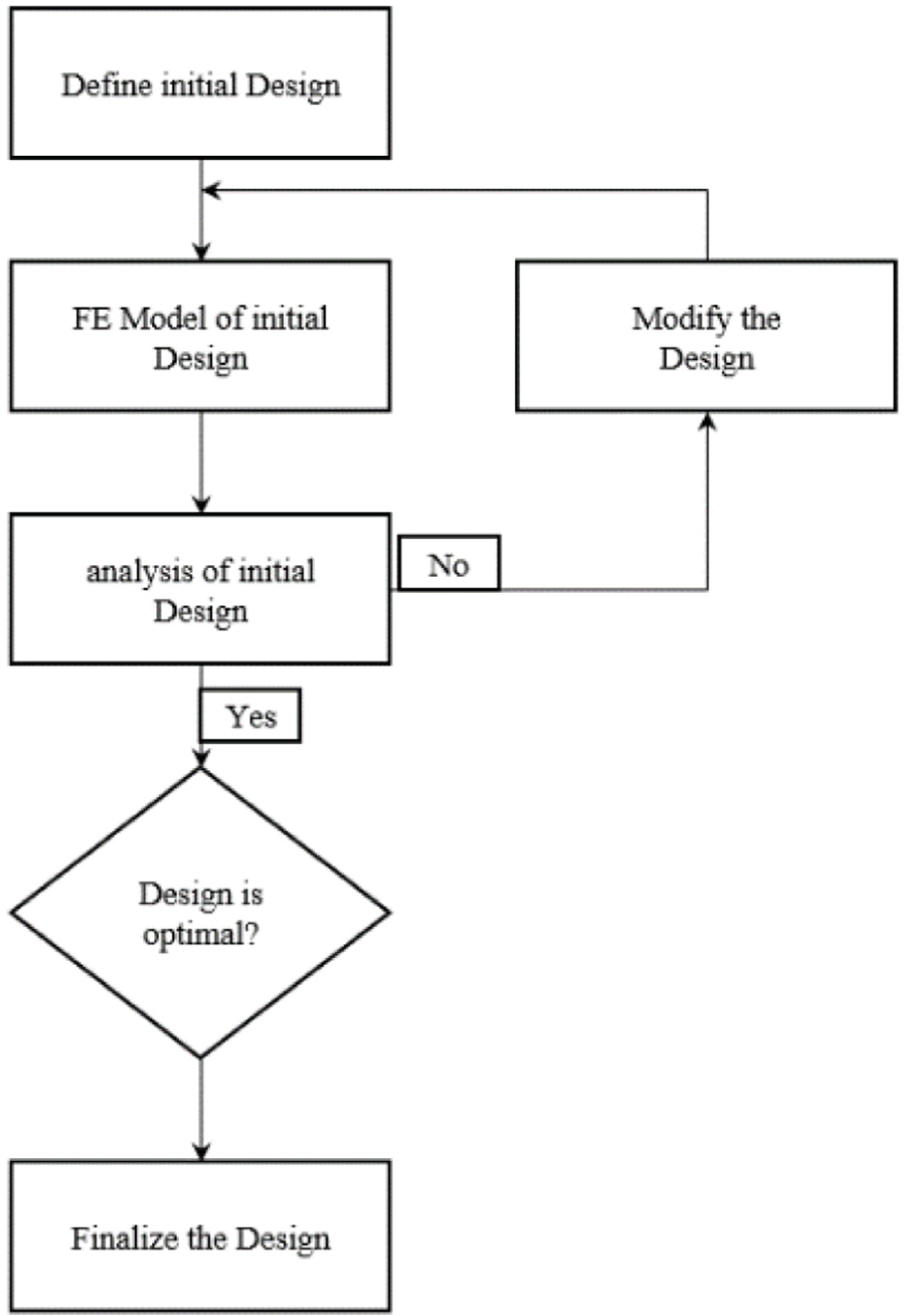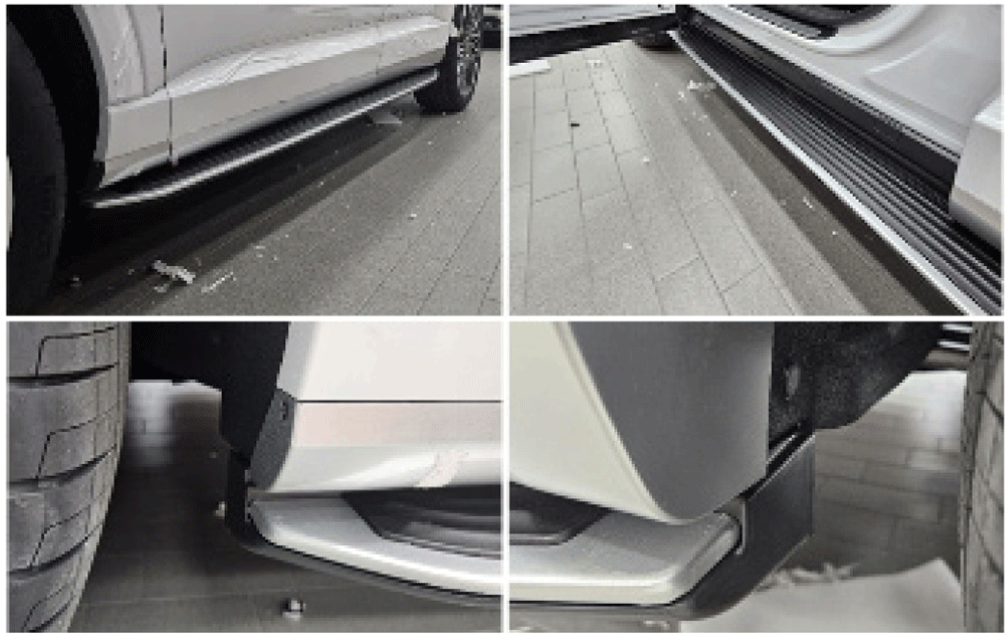Introduction
Side-steps, also known as running boards, have become an essential feature in the design of SUVs and MPVs. These components serve a dual purpose: enhancing accessibility for passengers and adding aesthetic value to the vehicle [1]. As SUVs and MPVs tend to have higher ground clearance than standard passenger cars, side-steps provide a convenient stepping platform, making it easier for occupants to enter and exit the vehicle, particularly for children, the elderly, and individuals with mobility issues. Additionally, side-steps often serve as a protective feature, guarding the lower portion of the vehicle body against road debris and minor impacts.
The need for customization in side-step design is critical due to the wide variety of vehicle types, consumer preferences, and functional requirements. Side-steps can range from simple, fixed designs to more sophisticated retractable models that deploy automatically when doors are opened. Customization considerations include material selection, aesthetic integration with the vehicle’s body, load-bearing capacity, and specific use cases such as off-road durability or luxury enhancements.
Customization is broadly defined as a strategic approach that enables the delivery of tailored products or services through flexible processes, allowing firms to remain competitive in dynamic markets [2]. In the context of manufacturing management, mass customization is closely linked to concepts such as flexible manufacturing systems and modular product architectures. Designing product architectures and enabling product configuration are key enablers of this strategy, offering a broader range of choices to customers and supporting product differentiation in saturated markets.
From a customer-centric perspective, customization leads to an increased variety of product offerings, each adapted to reflect the specific preferences and needs of individual consumers. In this regard, customization and personalization both play significant roles. While they are often perceived as interchangeable, they differ fundamentally in how customer requirements are sourced. Customization typically refers to the adjustment of a product based on explicit customer input, allowing users to select features from a predefined set of options. In contrast, personalization involves the producer adapting a product or service using implicit information inferred from consumer behavior [3].
Four customization strategies are outlines as —collaborative, adaptive, cosmetic, and transparent—each addressing customer needs differently [4]. Among these, collaborative customization is most commonly associated with mass customization, as it involves a co-creation process where customer requirements are directly gathered and reflected in the product design. In transparent customization, on the other hand, firms anticipate customer needs by analyzing behavioral data, thereby offering tailored solutions without requiring explicit customer input.
Further distinguishing these concepts, that personalization is typically firm-driven, where companies proactively tailor products or experiences based on analytics, while customization is customer-driven, initiated through individual choices and requests [5]. Personalization aims to address the preferences of each customer on a one-to-one basis, whereas customization often targets market segments, delivering tailored solutions to grouped customer types based on shared attributes [6].
Manufacturers must carefully balance these factors to deliver side-steps that are not only functional but also lightweight, durable, and visually appealing.
Despite their advantages, side-steps present challenges in terms of design and implementation. The addition of side-steps can increase vehicle weight, potentially reducing fuel efficiency. In more advanced models, the inclusion of retractable mechanisms introduces complexity, increasing the risk of mechanical or electrical failure. Additionally, side-steps must be designed to withstand harsh environmental conditions, including extreme temperatures, moisture, dirt, and impact from road debris [13].
This paper explores the functional need for side-steps in SUVs and MPVs, the advantages they offer, and the design challenges that arise during implementation. It also addresses the customization required to meet specific user needs and vehicle types, offering insights into the trade-offs between functionality, durability, and performance.
There are several types of running boards available on the market, each with their own set of features and benefits. Some of the most common types include:
One of the primary benefits of Side-steps is improved accessibility. They provide a stable and secure platform for passengers to step onto when entering or exiting a vehicle, which can be especially useful for children or elderly passengers. Side-steps also make it easier to load and unload cargo from the roof or bed of a truck, as they provide an extra step for reaching the top of the vehicle.
Side-steps also help to protect the vehicle’s paint and bodywork from damage. They provide a barrier between the vehicle and debris kicked up by the tires, which can help prevent scratches and dents on the doors and lower body panels.
Another benefit of Side-steps is that they can enhance the resale value of a vehicle. Vehicles with Side-steps are often perceived as being more desirable and valuable, as they offer both practical and aesthetic benefits.
Customization Strategy
Customization has emerged as a critical factor through which companies can distinguish their products from those of competitors. It empowers customers to configure final products to match their individual needs and preferences, thereby enhancing customer satisfaction and loyalty. Unlike the traditional model of offering a limited range of mass-produced items, customization significantly broadens a company’s product portfolio, attracting a more diverse customer base [8].
However, manufacturers today face increasing challenges in addressing these evolving consumer expectations. Customers now demand highly tailored products while simultaneously expecting delivery timelines, pricing, and quality standards comparable to those of standardized offerings. Implementing mass customization strategies often necessitates a substantial transformation of a company’s business operations and value chain.
Customization can be executed in two primary ways. The first is bespoke production, where a product is designed and manufactured entirely from scratch based on specific customer inputs—typically in a workshop-like setting with dedicated resources for each order. The second, more scalable approach is mass customization, which integrates the efficiency of mass production with the flexibility of product adaptation. The goal is to deliver individualized products at near mass-production efficiency [10].
While mass customization offers substantial benefits, it introduces complexity during the configuration phase. Customers are often faced with an overwhelming amount of information and similar-looking options, which can lead to confusion and decision fatigue. Common issues include unclear or overly complex product data and insufficient differentiation between available options.
To mitigate this, effective customer orientation and guidance are essential, especially through digital interfaces. Research has shown that website usability and ease of navigation significantly affect customer satisfaction and purchasing behavior. Poorly designed interfaces that obscure relevant information increase customer confusion and reduce engagement [11].
| Strategy Element | Description |
|---|---|
| Targeted Market Strategy | Focuses on a well-defined customer segment, potentially excluding others. |
| Sales and Development Tools | Uses advanced product configuration systems to support flexible customization during sales and product development. |
| Modular Product Line Architecture | Products are built using interchangeable modules, enabling tailored combinations for customer- specific needs. |
| Mass Production of Modules | Standard components are manufactured at scale and assembled into final products based on individual customer selections. |
| Post-Sale Service through Modularity | Maintenance and upgrades are simplified through modular replacement rather than full product overhaul [9]. |
A structured framework for mass customization, identifying seven levels at which customization can occur: Design, Production, Assembly, Additional Custom Work, Additional Service, Packaging and Distribution, and Applicability [12].
This layered approach underscores how customer involvement varies across different stages of the product life cycle, enabling firms to align their customization strategies with operational capabilities and market expectations.
Side-Step : Functional Need
The primary functional need for side-steps in SUVs and MPVs arises from the vehicles’ elevated ground clearance, which enhances off-road capability, road visibility, and safety. However, this height can make entry and exit challenging for passengers, particularly for children, the elderly, or those with limited mobility. Side-steps bridge this gap by providing a stable and easily accessible platform, significantly improving user convenience and safety.
Given these functional needs, the design of side-steps is not merely an aesthetic addition but a necessity for improving the practicality and usability of high-clearance vehicles like SUVs and MPVs. Understanding the specific functional requirements of different vehicle types and user demographics is essential for optimizing the design, ensuring safety, and enhancing user experience.
Ground clearance, the distance between the lowest point of a vehicle and the ground, is a critical factor in the design and customization of side steps for SUVs and MPVs. The addition of side steps can influence a vehicle’s ground clearance, impacting both functionality and performance.
Side steps, also known as nerf bars or step bars, are installed to aid passengers in entering and exiting vehicles with higher ground clearance. However, their installation can affect the vehicle’s ground clearance in the following ways [16]:
Reduction in Ground Clearance: Installing side steps can lower the vehicle’s ground clearance, as they are mounted below the doors and may extend downward. This reduction can be a concern for off-road driving, where maximum clearance is desired to navigate uneven terrains without obstruction [16].
Design Considerations: The extent to which ground clearance is affected depends on the design of the side steps. Some side steps are designed to minimize impact on ground clearance, making them more suitable for off-road use.
Side-Steps: Design to Implementation
The design of side-steps for SUVs and MPVs is a complex process that involves balancing aesthetics, functionality, and performance under varying conditions. Proper design ensures that side-steps fulfill their primary role of improving vehicle accessibility while also withstanding dynamic loads, environmental conditions, and user demands. Several design criteria must be considered, alongside load-bearing requirements and potential issues that can arise during implementation.
Structural Integrity: Side-steps must be robust enough to support the weight of passengers repeatedly without deforming or breaking. The frame should be designed with high-strength materials such as aluminum alloys, stainless steel, or reinforced composites to ensure durability and long-term performance. This is especially important in off-road vehicles where side-steps may encounter additional stresses from uneven terrain or impacts with debris.
| Design Aspect | Description |
|---|---|
| Weight Optimization | Use lightweight materials (e.g., aluminum, carbon fiber) to reduce impact on efficiency. |
| Corrosion Resistance | Apply protective finishes (e.g., powder coating, anodization) to withstand harsh environments. |
| Safety & Ergonomics | Ensure non-slip surfaces and ergonomic placement for safe, easy access [7]. |
| Aesthetic Integration | Blend with vehicle design; allow for customization (logos, colors) without affecting aerodynamics. |
Designing a side-step that can be easily assembled across various SUVs and MPVs presents significant challenges due to differences in vehicle dimensions, mounting points, and structural designs. However, a flexible and standardized assembly process is essential for manufacturers aiming to reduce production costs and ensure ease of installation, especially in aftermarket products. This section discusses the key assembly constraints, focusing on how side-steps can be designed to fit different vehicles while meeting functional, safety, and performance requirements.
-
Universal Mounting Systems:
-
Frame Compatibility:
-
Clearance and Fitment:
-
Load Distribution:
-
Material Compatibility and Corrosion Prevention:
-
Wiring and Electrical Connections (for Retractable Side-Steps):
-
Aesthetic Integration and Body Fit:
-
Regulatory and Safety Compliance:
To standardize side-step assembly across multiple SUV and MPV models, manufacturers must account for diverse vehicle structures, load requirements, and material compatibility. By employing adjustable, modular mounting systems, reinforced structures, and universal wiring solutions, side-steps can be designed to fit a wide range of vehicles with minimal customization. This approach allows for efficient assembly, reduces manufacturing complexity, and ensures that side-steps can be easily installed in both factory and aftermarket settings, all while maintaining functionality, safety, and aesthetic integrity.
The use of Computer-Aided Engineering (CAE) is essential in the design and development of vehicle side-steps. CAE tools enable engineers to simulate, analyze, and optimize the performance of side-steps under various conditions before physical prototypes are produced. This process ensures that the side-steps meet strength, durability, and safety requirements, while also addressing issues such as weight reduction, material efficiency, and ease of assembly. Below is an overview of the key CAE processes used in the development of side-steps, along with typical challenges and solutions.
| Load Cases | Displacement, mm | |
|---|---|---|
| TEST | CAE | |
| Load Case-1 | 100% | 92.5% |
| Load Case-2 | 100% | 97.5% |
| Load Case-3 | 100% | 90.1% |
| Load Case-4 | 100% | 95.6% |
Summary & Conclusion
The study provides a comprehensive analysis of side-step design, functionality, and implementation. The paper discusses the types and benefits of side-steps, emphasizing their significance in enhancing accessibility, vehicle protection, and aesthetics.
The functional need for side-steps is explored, particularly in relation to ground clearance and its impact on vehicle performance. Since SUVs and MPVs are designed with higher ground clearance, side-steps serve as a critical accessibility aid while also influencing aerodynamics and off-road capability.
The design and implementation aspects of side-steps are thoroughly examined, focusing on structural integrity, load-bearing capacity, material selection, and manufacturing constraints. The study highlights the importance of balancing weight optimization, strength, and durability while ensuring that the materials used—such as aluminum, steel, composites, and CFRP—align with performance requirements. Key assembly constraints and the need for standardization across different vehicle platforms are also discussed.
Furthermore, the paper covers the CAE (Computer-Aided Engineering) process, which plays a crucial role in optimizing side-step designs by evaluating stress distribution, load-bearing capacity, and material efficiency. Understanding these engineering considerations is vital to improving safety, performance, and production feasibility.
The research underscores that side-step design and customization are not merely aesthetic enhancements but essential components for SUVs and MPVs, addressing functional, safety, and durability concerns. The successful development of side-steps requires a holistic approach, integrating material science, structural engineering, and advanced manufacturing techniques.
While side-steps offer improved accessibility, vehicle protection, and styling advantages, challenges such as weight trade-offs, environmental resistance, ground clearance interference, and cost considerations must be addressed. Future research should focus on CAE-driven optimization to refine the strength-to-weight ratio, aerodynamic efficiency, and material sustainability of side-steps.
As the industry advances, further studies will explore Side-Step Section CAE and Optimization, ensuring enhanced performance, durability, and manufacturability to meet evolving automotive design and consumer demands.







